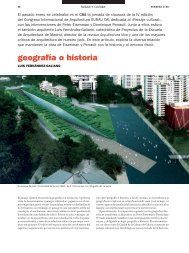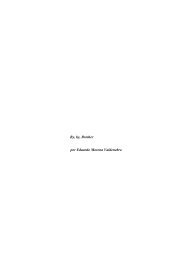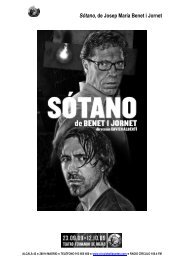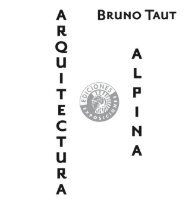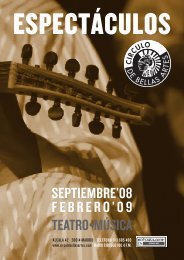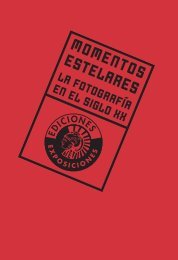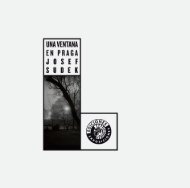Goethe 01-13.indd - Círculo de Bellas Artes
Goethe 01-13.indd - Círculo de Bellas Artes
Goethe 01-13.indd - Círculo de Bellas Artes
Create successful ePaper yourself
Turn your PDF publications into a flip-book with our unique Google optimized e-Paper software.
julio <strong>de</strong> 1787<br />
Lápiz, pluma y aguada sepia; sobre papel blanco<br />
Parte posterior: construcción <strong>de</strong> un sistema <strong>de</strong> perspectiva <strong>de</strong> dos puntos<br />
y alusión a una representación <strong>de</strong> perspectiva central<br />
15,5 x 27,5 cm<br />
Corpus II Nr. 197 / Nr. <strong>de</strong> inv. 2277<br />
Depósito <strong>de</strong> Nicolaus Graf Henckel von Donnersmarck<br />
Bibliografía: Günther Bergmann, <strong>Goethe</strong> – Der Zeichner und Maler.<br />
Ein Porträt, Múnich, 1999, pp. 142 y ss.<br />
[34] ACQUA ACETOSA En el amplio paisaje <strong>de</strong> la Campagna al norte <strong>de</strong> Roma<br />
–<strong>de</strong>s<strong>de</strong> Claudio Lorena y Nicolas Poussin <strong>de</strong>pósito <strong>de</strong><br />
increíbles motivos para muchos pintores– brotaba a borbotones<br />
<strong>de</strong>s<strong>de</strong> hacía sus buenos doscientos años un<br />
manantial medicinal muy visitado, el Acqua Acetosa [Agua<br />
agria]. En 1660 el pintor y arquitecto Andrea Sacchi 1 lo<br />
había canalizado en una fuente <strong>de</strong> arquitectura barroca<br />
sin adornos. Hoy, esta fuente se halla totalmente olvidada<br />
en el bullicio <strong>de</strong>l tráfi co <strong>de</strong> Roma, y «nada recuerda el<br />
antiguo encanto <strong>de</strong> este lugar» 2 .<br />
En el verano <strong>de</strong> 1787 <strong>Goethe</strong> aprovechó a menudo<br />
el ligero efecto laxante <strong>de</strong> esta agua medicinal:<br />
El calor es violento. Por las mañanas, a la salida <strong>de</strong>l<br />
sol, me levanto y me dirijo hacia Aqcua Acetosa, una<br />
fuente agria, a una media hora <strong>de</strong> la puerta cerca<br />
<strong>de</strong> la que vivo, bebo agua, que sabe como el agua<br />
1 Andrea Sacchi (1599-1661).<br />
2 Bergmann, 1999, p. 144.<br />
3 WA I, 32, p. 27.<br />
mineral <strong>de</strong> Schwalbach pero que en este clima es<br />
muy efectiva. […] En el dibujo sigo a<strong>de</strong>lante formando<br />
mi mano y mi gusto, he comenzado a impulsar<br />
seriamente la arquitectura, todo me resulta sorpren<strong>de</strong>ntemente<br />
sencillo (esto es el concepto que exige<br />
el ejercicio <strong>de</strong> una vida) 3 .<br />
La mano bien entrenada sobre cuyo ejercicio progresivo<br />
escribe <strong>Goethe</strong> en su informe Segunda estancia<br />
romana <strong>de</strong>l 5 <strong>de</strong> julio <strong>de</strong> 1787 en Viaje a Italia pue<strong>de</strong><br />
apreciarse bien en el dibujo Aqcua Acetosa –un dibujo<br />
surgido en esta fase–. <strong>Goethe</strong> se hizo con las siluetas<br />
<strong>de</strong> las casas <strong>de</strong> la fuente y el paisaje en una <strong>de</strong> sus visitas<br />
al lugar. En la elaboración mediante el difuminado en<br />
gris con la pluma, así como con la luz y las sombras, el<br />
pequeño dibujo transmite efi cazmente la amplitud <strong>de</strong> la<br />
campiña romana.



